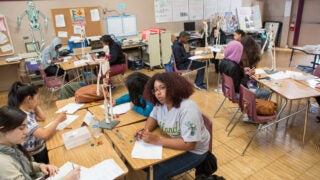
(Illustration/Brian Stauffer)
What Will Our World Look Like in 2050?
USC researchers say confronting reality and taking local action may help humanity cope — and even spur economies and innovation.
It’s 2050, and another balmy day in Los Angeles. A young woman steps outside and puts on her air filtration mask. The air is thick with smog, which aggravates her asthma. As she hurries to get into an air-conditioned, self-driving car, she wonders if the temperature will finally dip below 90 degrees today — for the first time this November.
One hundred miles northwest, a third-generation vineyard owner finishes packing up his family and saying goodbye to the land. It has become too hot to produce his Pinot Noir grapes anymore — all the nearby vineyards now grow wheat to fit the hotter weather. He is heading to Oregon’s cooler climes to start again.
Meanwhile, on the coast, a boy and his grandfather walk along the beach, careful not to touch the water. A telltale bright red stain in the waves warns them of a toxic algal bloom. The water level has risen a little bit over the years, and the grandfather wonders how much land will still be above water when his grandson reaches his age.
By 2050, climate change and its reality will no longer be up for debate. The subtle signs we’re starting to see around us will be more pronounced, scientists say, and their impact will be easy to spot in everyday life. The warming trend can feel overwhelming to understand, much less confront — especially with so many factors believed to affect how the planet is changing. But there’s good news: Humanity has tools to shape our future, USC researchers say, and some are already working in places across the globe.
 (Illustration/Brian Stauffer)
(Illustration/Brian Stauffer)
Weather in 2050: Hot, Hotter, Hottest
“The global climate is like an aircraft carrier; turning it around is slow,” says Julien Emile-Geay, an associate professor of Earth sciences at the USC Dornsife College of Letters, Arts and Sciences. “If we don’t start now, we’ll be stuck in a very tough place in 2050.” As an expert in climate dynamics, Emile-Geay has devoted his career to understanding what’s coming for the planet.
The 20th century was Earth’s warmest period in nearly 2,000 years, he says. Data he examined from a wide variety of sources, including ice cores, tree rings and coral reefs, show that the warming trend began after the industrial revolution—the 1850s. For most of the globe, the warmest temperatures have come within the past 100 years. He agrees with the broad scientific consensus that if the trend continues — and physics says it will — sea level rise and droughts could render areas of the planet unsafe or even uninhabitable. Refugees leaving their homes for livable climates could lead to geopolitical instability. The World Bank predicts as many as 140 million people could be displaced by 2050.
In the Southern California of 2050, Angelenos could spend a quarter of the year sweating it out in temperatures of 90 degrees or more. That’s 95 days of dangerously hot weather a year, significantly higher than the 67 days we see in 2019. Air conditioning will raise energy bills, but researchers anticipate costs to health as well.
When temperatures spike, deaths rise too, says USC Dornsife environmental economist Paulina Oliva. Research suggests that uncomfortable heat stresses the body, increasing risk of heart problems and stroke, especially in the elderly. High temperatures have also been linked to an increase in pre-term births and infant mortality. Studies on students and stockbrokers and other workers have shown that temperatures above 80 degrees slow down thinking processes, making it harder to focus and make decisions. These problems disproportionately harm people with the fewest resources to deal with the discomfort and health risks.
Several researchers raise the alarm that any climate plan has to address our society’s systemic inequalities. “The pregnant mother who doesn’t have a car is going to have to walk to public transportation and expose her baby to these high temperatures in utero,” Oliva says. “Even though we do have means to adapt, wealthier people are going to be better able to adapt than poor people.”
The climate is likely to become extreme in several ways, including an increase in both fires and floods, rainy days and droughts, cold snaps and temperature spikes. In California, unpredictable fluctuations could devastate the agricultural sector, which accounts for an eighth of the country’s agricultural production. It’s likely that some crops, like grapes and apples, could only be grown farther north. Farmers who opt to stay in California might switch products — say, from corn to wheat — to better match the new climate reality.
Environment in 2050: Something in the Air
We don’t need to time travel to 2050 to imagine the impact of climate change on the air. In spring 2018, Los Angeles’ air quality exceeded federal safety levels for 87 days, says Antonio Bento, director of the USC Center for Sustainability Solutions and professor at the USC Price School of Public Policy and the Department of Economics.
When temperatures rise, so does “bad” ozone. Don’t confuse this ozone with the ozone layer in the upper atmosphere, which shields Earth from the sun’s radiation. Bad ozone forms at ground level when pollutants from cars and other industrial sources react to sunlight. “Ozone is dependent on temperature, sunlight and heat waves,” Bento says. “That means that higher heat brings on worse air quality.”
In Los Angeles, it’s one of the biggest reasons climate change endangers human health: More days above 90 degrees means more ozone, more asthma, more lung damage and more deaths. By 2050, if climate mitigation strategies and air pollution regulation don’t halt rising temperatures, the skies of Los Angeles could revert to the soupy smog of the 1970s, Bento says.
That was a time before the Clean Air Act, when more than half the days in the city had unsafe levels of pollution. Angelenos couldn’t see the mountains through the thick smog. “In part due to climate change, many of the benefits that we have achieved are quickly being undone,” says Bento, who recently published research showing how a rollback of vehicle emissions standards would be dangerous. “We have arrived at a point where for us to prevent major damage, we would have to rely on adaptation.”
For a long time, Bento was sure that leaders would take up the urgent issue of climate change based on a global consensus, so he focused his policy recommendations on broad, far-reaching solutions. But recently, he shifted his thinking. He’s increasingly examining how local policy changes could benefit countries and states.
Reducing greenhouse gas emissions would not only reduce health problems related to air pollution impacts, but it also could bring along other benefits, like spurring technological innovation, improving the reliability of the power supply by diversifying energy sources, reducing fuel costs and boosting employment.
“If we account for these co-benefits of climate action, it’s in the best interest of countries to act independently of what others are doing,” he says. “And it’s in the best interest of California to implement climate policies, because even if others don’t act, we will get these additional benefits.”
Bento has worked with the city of Los Angeles and other local governments in the U.S. and abroad to craft climate-mitigation strategies. By 2050, 68% of the world population will live in cities, up from 55% today, so the actions of municipal and regional governments are critical. “If cities become the unit at which we do climate policy, we end up with comprehensive climate legislation even without national leadership,” he explains. “That’s the future of our cities and the environment. It really depends on how we communicate the climate crisis to the public.”
Bento is also researching ways to create optimal carbon pricing, which shifts responsibility back to the producers of greenhouse gas emissions. Carbon pricing works by estimating the external cost of a company’s greenhouse gas emissions and issuing a tax. This puts the financial burden on businesses instead of on local and vulnerable communities, while also financially incentivizing companies to opt for cleaner technology.
“It’s frustrating, because we have known how to do these things for decades, but we’re not yet doing them,” he says. “As we move toward 2050, we have to adapt in ways that don’t put more burdens on communities that are vulnerable already.”
 (Illustration/Brian Stauffer)
(Illustration/Brian Stauffer)
Oceans and Water in 2050: Beneath the Surface
More than 90% of the warming created by humans since the 1970s has been absorbed by the oceans. And just as on land, there is a shift underway in the sea that will affect the global oceans of 2050, says David Hutchins, a USC Dornsife professor of marine and environmental biology. “The ocean is warming, acidifying, losing oxygen and being overfished and choked with pollutants ranging from nutrients to plastic,” he says. “Nearly the entire marine environment is in flux right now.”
Numbers of large predator fish have plunged, and about half of the world’s coral reefs have been lost to bleaching caused by warming temperatures, Hutchins says. By 2050, most reefs may have vanished, according to a National Oceanic and Atmospheric Administration report.
Some governments, like Australia’s, are taking action, trying to protect reefs by reducing other threats to coral such as dredging and runoff from land. And scientists are identifying and growing types of resistant coral that may be better able to cope with warm water.
In Southern California, people will have to deal with rising sea levels as polar ice continues to melt. Some of California’s most valuable coastal real estate may go underwater later this century, Hutchins says. Another aquatic impact: unwelcome bursts of harmful algal blooms that thrive in warmer waters and poison human and marine life.
“The climate emergency is happening now, today, not sometime in the far-off future,” Hutchins says. “I’d like people to think about the kind of world we want to leave for our children and grandchildren, and to make our choices — from the way we live to the leaders we vote for — with that in mind. There is literally no time to lose.”
Water distribution across the planet is a challenge, too: By 2050, more parts of the world will go through droughts, while others will be deluged with floods. It’s hard to believe that a place like Phuket, Thailand, could suffer from a water shortage when about 100 inches of rain falls there per year, says Amy Childress, the Gabilan Distinguished Professor in Science and Engineering at the USC Viterbi School of Engineering. But right before the monsoon season begins, the reservoirs can get very low as reserves from the last monsoon season dwindle.
Areas like Phuket can’t wait until 2050 to figure out a sustainable plan for their water supply; they need to plan now. That goes for California, too.
“In Southern California, we are simultaneously preparing for the drought scenario — alternative water supplies, expansion of the water supply portfolio — and the flood scenario, which includes dam maintenance and flood risk management,” Childress says. Then there’s the water we need to drink.
In the future, more people will depend on drinking water that’s been recycled. The idea of drinking water that’s “secondhand” from wastewater or other human uses is off-putting to many, maybe because the public prefers to think it should come from a pristine mountain stream, Childress says. That’s not realistic, even today. “Typically, our drinking water comes from a source that was used upstream by others and is being reused by us,” she says. “We have regulations in place to ensure that this practice is safe.”
In addition to recycled water, Californians of 2050 will rely more on desalinated seawater, she predicts. Desalinating seawater is usually the last choice for a region’s water supply because the process is so energy intensive, but it is a reliable supply that will become more useful in the years to come. Right now, 12 desalination plants operate in California, but ocean filtration systems operate in more than 120 countries and are especially critical in countries in the Middle East and the Mediterranean.
 (Illustration/Brian Stauffer)
(Illustration/Brian Stauffer)
Lifestyle in 2050: Changes at Home
For a long time, Bento says, academics were so concerned with getting their climate change models right — and assessing broad existential threats — they failed to communicate how changes are already affecting daily life. That’s no longer the case.
Commuting, travel, shopping, eating, housing — they all may be transformed by 2050 as people come to understand their effect on the planet. Bento, for one, already drives an electric car, but he questions whether he needs one at all. “It was just such an unquestioned expectation for me, that I would get a car as a teenager,” he explains. “And when electric vehicles arrived, I thought I was doing something for the environment. But now we are moving into new models. “If we could move to a system that is more efficient, and that integrates density of development with public transit and car-sharing, perhaps we could have much better outcomes.”
Earth scientist Emile-Geay has cut travel to most academic conferences. Instead of flying several times a year to meet other scientists — trips that leave a big carbon footprint — he chooses just one conference to attend. “I started to ask myself: What am I getting out of these conferences and what do others get from my presence?” he says. “And so I prioritize small, more intimate gatherings where there’s a real exchange of ideas.”
Similarly, when people travel for pleasure in the future, more could opt to use low-carbon transportation to explore their own regions instead of taking trips to faraway countries. Besides changing his travel habits, Emile-Geay also has stopped eating meat, and tries to choose foods grown as locally as possible.
“Some like to pit a healthy planet against a healthy economy,” he says. “That’s a false dichotomy. It’s in our power to build an economy centered on ecological and humanistic values instead. The laws of physics won’t change, but our laws can.” A possible low-carbon future, he says, could include less driving and more local focus, leaving more time with family and friends, which creates safer communities with stronger social bonds.
Oliva sees promise for slowing climate change, as more governments around the world seek immediate action. “And also, we’re not sitting and waiting around here,” she says of California. “There’s quite a bit of progress being made at the state and local level.” She believes the state is a model for how sustainability and business can work together. “We’re showing that these climate policies really are not going to be as costly as they’re being portrayed,” Oliva says. “California was an early adopter of stricter greenhouse gas policies and businesses didn’t all flee the state. So that gives me hope.”
Emile-Geay sees an opportunity for a more civic-oriented and equitable future. Supply chains could be more efficient. Instead of shoppers ordering a product from across the Pacific, a neighborhood 3D printer could fabricate the items people need and a bicycle courier could ferry it to their homes. He even imagines climate change spurring people to rethink the way they live.
“It’s like somebody being given a diagnosis of a terminal illness. It’s a wake-up call. Suddenly it makes you ask: ‘What am I doing with the rest of my time on Earth?’” he says. “That could be the kick we need to re-engineer our social networks and get more local, more focused on community, which is what many psychologists and social scientists say is good for us anyway.”



